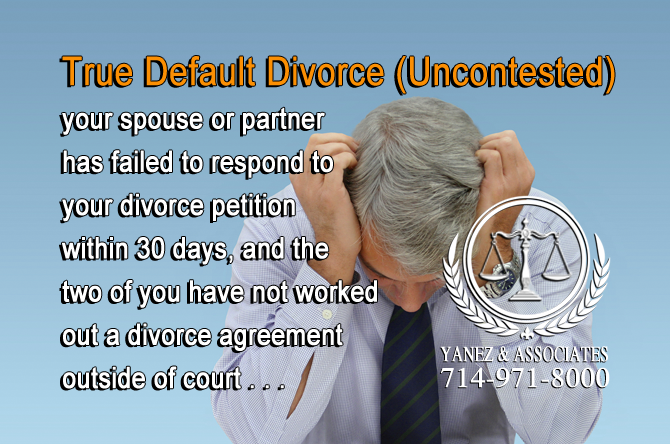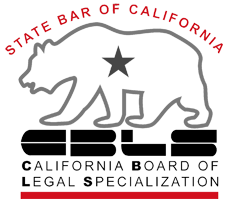What if the Other Party Does Not Respond to My California Divorce Petition?
When you file for a divorce in California, your first steps after finding a lawyer include filling out and filing a divorce petition and some additional paperwork with the court, and then serving the petition on your spouse or partner. In most cases, your spouse has 30 days from the date he or she was served to respond to your petition. (Military divorces and special circumstances can extend this deadline.)
In those 30 days, your spouse has several options for what to do. Based on which of the following he or she chooses, you can determine how to move forward.
• Nothing - In this case, your spouse simply ignores the divorce petition, and essentially gives up his or her right to participate or have a say in the divorce. This is called a True Default, and will lead to an uncontested divorce.
• Discuss the divorce with you outside of court - Your spouse may choose not to respond to your petition through the courts, but try to work out a divorce settlement with you outside of court. This is also considered an uncontested divorce, and is called a “default with agreement”.
• File a response with the court and work out an agreement with you outside of the court - If your spouse files a response with the court and the two of you can come up with a divorce agreement without going to trial, this is considered an uncontested divorce.
• File a response in disagreement with you - If you and your spouse or partner cannot come to an agreement on your divorce on your own, and your spouse chooses to file a response in court, your divorce is considered to be contested.
If your spouse does not file a response with the court, your divorce will legally be uncontested because you and your spouse are not arguing over the details of your divorce agreement. You may or may not choose to work out a divorce agreement with your spouse or partner outside of the courts, but your next steps are important in getting the result you want.
A True Default Divorce (Uncontested)
In a true default divorce, your spouse or partner has failed to respond to your divorce petition within 30 days, and the two of you have not worked out a divorce agreement outside of court.
In this case, your divorce is considered uncontested, because you are not arguing over the terms of your divorce agreement. If your spouse failed to respond to your petition within 30 days, he or she has given up his or her right to participate in the divorce.
Failing to respond to a divorce petition does not prevent you from obtaining a divorce. Only the partner or spouse who filed for divorce can decide to cancel it, so your spouse’s only option for cancelling the divorce is to talk you out of it.
It is likely that you will be awarded the divorce agreement that you requested in your divorce petition as long as the judge agrees with what you asked for. If your child custody or child support requests are unreasonable or not made in the best interest of the child, they may need to be changed before the judge will agree. However, if the other parent is not taking any action to have custody of the child, he or she will likely not be awarded custody.
Your next steps are below.
You’ll need to fill out the following forms for the court.
• Request to Enter Default
• Declaration for Default or Uncontested Dissolution
• Judgment
• Notice of Entry of Judgment
• Any additional forms that may apply to your case, including those relating to child custody and visitation, child support, spousal support, and the division of property. Make sure to discuss your case with your divorce attorney so that you know you are covering all of your bases and not leaving anything out.
• Local forms that may be required in your area
It is important to discuss which forms you’ll need with your divorce attorney, and to have your lawyer look over your forms prior to filing them with the court.
Make two copies of all of your forms: one for you, and one for your spouse. The originals will be filed with the court. When you file, have the following completed and ready to submit to the clerk.
• Proof of Service of Summons
• Declaration Regarding Service of Declaration of Disclosure
When your divorce is granted, the clerk will mail the Judgment and Notice of Entry of Judgment to both you and your spouse or partner. Always keep a copy of all court orders in case you need them - especially if you need to modify or enforce them at a later date.
A Default Divorce with an Agreement (Uncontested)

The other situation that may arise if your spouse does not respond to your divorce petition is called a default divorce with an agreement. In this situation, your spouse or partner does not file a response with the court, but reaches out to you outside of court to create a divorce agreement.
If this is the case, your next step is to work together with your spouse or partner to create a divorce agreement that you can submit to the judge for approval. Your agreement will need to cover the following.
• Property Division - You and your spouse or partner will have shared property, debts and other assets that need to be divided between you during your divorce. This can include things like your home and vehicles, bank accounts, credit card debts, retirement accounts, and more.
• Spousal Support - You and your spouse or partner will need to decide whether either of you will need child support, and how much it should be. You may want to discuss this with a professional, especially if you aren’t sure.
• Child Custody and Visitation - If you share children with your spouse or partner, or if either of you are currently pregnant, you will need to create a child custody and visitation agreement in the best interest of the child.
• Child Support - This section may not be up to you and your spouse. If you have a child together, you are both financially responsible for supporting that child. However, in order to move forward with your divorce, you will need a child support agreement.
There are several ways that you can create a divorce agreement outside of courts. It may be difficult to create one between you and your spouse without professional assistance, and it is always advised that you have an attorney look over your agreement before signing it.
Alternative dispute resolutions are methods of resolving things like disagreements over a divorce agreement without going through the courts. The most commonly used methods in a divorce are divorce mediation and collaborative law/collaborative divorce.
Divorce mediation consists of you and your spouse working with a neutral third party mediator. The mediator’s job is to facilitate a productive conversation between you and your spouse or partner so that you can work through your issues. The mediator will usually start by asking both of you what your goals are for mediation, and throughout the process, help you reach those goals together. While neither party is allowed to have an attorney present during mediation, it is advised that you have a California divorce lawyer look over your divorce agreement prior to signing it.
Collaborative law, or collaborative divorce, is another method for resolving your divorce outside of court. You and your spouse or partner, along with your divorce lawyers, will work together outside of the courtroom to create a divorce agreement that works for both of you.
Remember that for an uncontested divorce, you will need to have your divorce agreement notarized.
To file for divorce, you’ll need the following forms.
• Request to Enter Default
• Declaration for Default or Uncontested Dissolution
• Judgment
• Notice of Entry Judgment
• Your signed and notarized divorce agreement
• Declaration Regarding Service of Declaration of Disclosure
• Any additional child support or child custody forms
• Spousal support forms
• Any local court forms that may be required in your court
Make sure that you have two copies of all forms: one for you and one for your spouse. The original will be filed with the court. At the time of filing, you can also submit the following:
• Proof of Service of Summons
• Declaration Regarding Service of Declaration of Disclosure
As long as your forms are filled out correctly, your final judgment will be mailed to you and your spouse or partner. It is important to keep these forms, in addition to copies of all associated court orders regarding child custody, child support, spousal support, etc. That way, if you need to modify or enforce these orders later, you can do so.
Orange County CA Divorce Attorney

If you have questions about your divorce, contact the attorneys at Yanez & Associates today to schedule your free initial consultation. We are here to help you throughout the divorce process.









